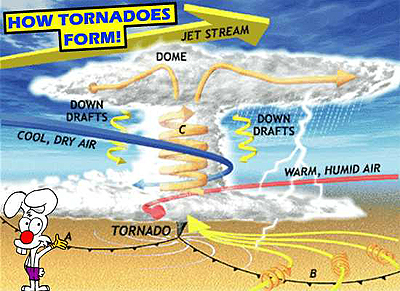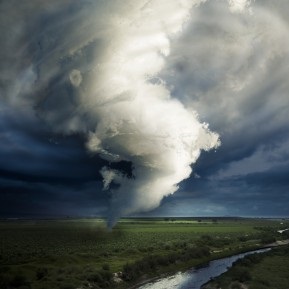Tornado Facts for Kids
Interested in learning more about tornadoes? Are you a student looking up information for a class project? Then you've come to the right place! We've put together these tornado facts for kids to help you with the learning and research process. You can learn more about tornadoes by visiting our Tornado Facts homepage.
If you're doing a school project you can freely use the information on this web page if you give properly reference this website. If you want to report any inaccurate information please contact us.
- Tornadoes are also referred to as cyclones or twisters.
- A tornado is a violent weather event.
- A tornado generally has a grey color tint and looks like an elephant's trunk.
- The majority of tornadoes have a wind speed than is less than 100 miles per hour.
- The majority of tornadoes only travel a few miles before they dissipate.
- The majority of tornadoes only last for a few minutes.
- Extreme tornadoes can have wind speeds that reach 300+ miles per hour.
- Extreme tornadoes can travel 100+ miles before they dissipate.
- Extreme tornadoes can last on the ground for over an hour before they dissipate.
- There are about 1,000 to 1,200 tornadoes annually in the United States.
- The Fujita Scale and Enhanced Fujita Scale are used to measure the strength of tornadoes.
- Areas in the U.S. with the most tornadoes are Texas, Oklahoma, Kansas and Florida.
- The region(s) that have a frequent occurrence of tornadoes are called tornado alley.
- The 1925 Tri-State Tornado was the deadliest tornado in U.S. history, it killed 695 people.
- A tornado hit Bangladesh in 1989 and killed 1,300+ people making it the deadliest tornado ever.
- Doppler radar is used to detect tornadoes by looking for large rotating updrafts in supercells.
- A tornado that forms or travels over water is called a waterspout.
- Tornadoes in the southern hemisphere usually rotate clockwise.
- Tornadoes in the northern hemisphere usually rotate counterclockwise.
- A tornado watch is issued when the conditions are right for the formation of a tornado.
- A tornado warning is issued when a funnel cloud has been sighted or a meteorologist has detected a tornado using Doppler radar.
- A basement, storm cellar or underground area is the safest place to be during a tornado.

You might also want to check out our web page with general tornado facts. If you live in an area with a high occurrence of tornadoes we recommend you read our web page with tornado safety facts. Head on over to our tornado myths archive to learn about all the misinformation surrounding torandoes.
